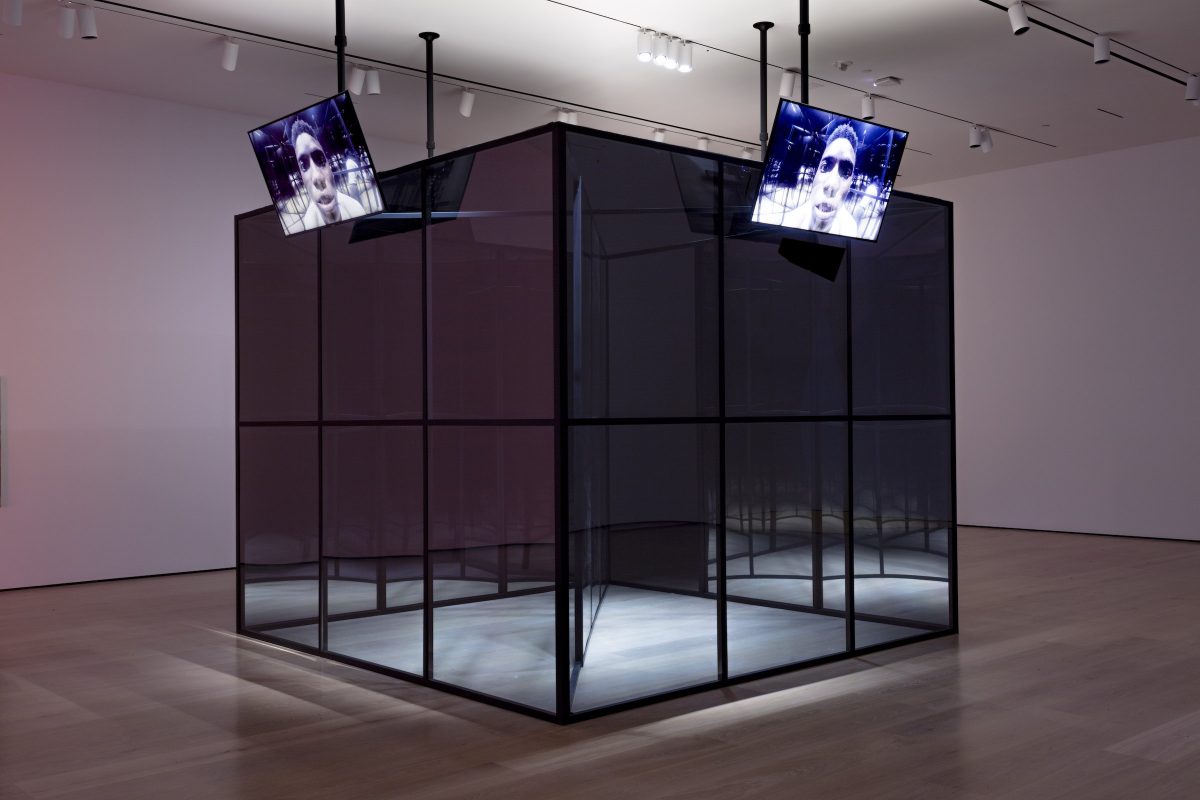
LOS ANGELES — Entertainment, horror, and the fourth wall: This year’s Made in LA biennial tears down the illusion of reality with the help of theater — revealing how illusion and reality are nothing more than versions of one another. Perhaps no other city understands this better than Los Angeles, a city whose reality has always been entwined with its simulacrum. Aptly titled A Version, the biennial was organized by independent curators Myriam Ben Salah and Lauren Mackler, along with the Hammer’s assistant curator of performance Ikechúkwú Onyewuenyi, and unfolds over two main venues across Los Angeles, one at the Hammer Museum and the other at the Huntington Library.
A perfect case in point is Aria Dean’s “King of the Loop” (2020), which acts as the center of gravity for the version of the biennial presented at the Hammer Museum. The sculpture features a partially reflective mirrored box with television monitors displaying a performance of an actor, who is left alone to wrestle with his thoughts after being abandoned on a plantation. The actor sees himself surrounded by his image, reflected and refracted, inside the mirrored cage; meanwhile, the spectator sees their reflection superimposed atop the empty box, watching themselves watch his performance. If it sounds complicated, that’s because it is — as its name suggests, “King of the Loop” effectively ricochets the gaze from objectifying to subjectifying, in a convoluted and never-ending loop.

The piece sets the viewer up to be hyperaware of their own viewership throughout the rest of the exhibition, a useful impulse when viewing the works of other artists such as Patrick Johnson, Niloufar Emamifar, and Jacqueline Kiyomi Gork. Though the theme of performance is explored in their work, such as through spectacle and spectatorship, it is when it is held up against a history of oppression that performance takes on a new subversive meaning. Mexican-born artist Reynaldo Rivera’s black-and-white photographs, for example, document East LA’s queer nightlife throughout the 1980s and 1990s. His images capturing performers behind-the-scenes as they ready themselves, their images doubled by the dressing room mirrors, serve as powerful reminders that performance has always been essential as a means of survival in order to participate in the fiction of America.

Across the city, another version plays out at the Huntington Library. Located in the historically WASP-y enclave of San Marino, the Huntington seems a curious choice for a second venue. But in a brilliant curatorial move, Ben Salah and Mackler take advantage of the Huntington’s elite status to deconstruct whiteness as its own mythology, one whose fiction oftentimes folds back upon itself as fact. Against the rarified setting of the Huntington, for example, the work of Buck Ellison gains particular resonance. Ellison’s photographs (a medium which already mistakes illusion for reality) display scenes that are so natural, they are almost banal. Girls at boarding school playing lacrosse. A pair of cufflinks on top of a desk, scattered with bouquets of roses, tennis balls, and financial statements. By staging these scenes so deliberately, with such clearly coded markers of race and wealth, and inserting into them into the carefully manicured displays of the museum’s neoclassical galleries, Ellison exposes the lifestyle taken for granted by many Americans as one that is as equally constructed as his staged photographs.

Several other artists also engage with the institutional context of the Huntington. Again, Aria Dean’s work looms large, this time manifested by her sculpture “Ironic Ionic Replica” (2020), a reproduction of Robert Venturi’s “Ironic Column.” Dean hearkens back to the legacy of the classical as a series of imitations upon imitations, calling attention to the fact that the construction of the “classical” is just that: a construction. Others directly reference the museum’s storied collection, as with Jill Mulleady’s trompe-l’oeil of Henry Fuseli’s iconic painting “The Three Witches,” or Monica Majoli’s installation featuring the archives of one of the earliest gay magazines in circulation, Blueboy, alluding to Thomas Gainsborough’s portrait of the same name.

The installation of the biennial further emphasizes these tropes, with walls left deconstructed, artworks meant to look like didactic wall texts, and even the insertion of a haunted house — creating a play within a play — in an effort to be transparent about the exhibition space as a form of theater as well. Strangely, the fact that the biennial is taking place during the COVID-19 pandemic only serves to heighten this sense of theater. Here, the fourth wall is indeed broken, not only through the curatorial texts acknowledging the difficulty of dealing with the pandemic in the midst of the show, but also through the arrows on the floor and signage everywhere orchestrating the movement of the viewer. In examining the mechanisms of theater, Made in LA uncovers the performance inherent not just throughout the exhibition, but also in everyday life — leaving viewers with the agency to decide how to act.
Made in LA: A Version continues by appointment at the Hammer Museum (10899 Wilshire Boulevard, Westwood, Los Angeles) and Huntington (1151 Oxford Road, San Marino, Calif.) through August 1. The exhibition was curated by Myriam Ben Salah and Lauren Mackler with Ikechúkwú Onyewuenyi.
0 Commentaires